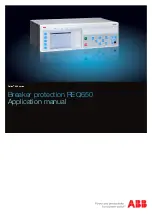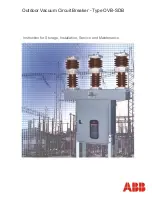
32
Vacuum interrupters may emit X-ray radiation.
Can result in serious injury.
Keep personnel more than six feet away from a circuit breaker under test.
High-potential tests
The next series of tests (vacuum-integrity test
and insulation tests) involve use of high-
voltage test equipment. The circuit breaker
under test should be inside a suitable test
barrier equipped with warning lights.
Vacuum-integrity check (using dielectric
test)
A high-potential test is used to verify the
vacuum integrity of the circuit breaker. The
test is conducted on the circuit breaker with
its primary contacts in the open position.
Vacuum integrity test procedure
1. Observe safety precautions listed in the
danger and warning advisories. Construct
the proper barrier and warning light
system.
2. Ground the frame of the circuit breaker,
and ground each pole not under test.
3. Apply test voltage (refer to Table 4: High-
potential test voltages on page 33) across
each pole for one minute (circuit breaker
open).
4. If the pole sustains the test voltage for
that period, its vacuum integrity has been
verified.
Note:
Do not use dc high-potential testers
incorporating half-wave rectification. These
devices produce high peak voltages.
High peak voltages will produce X-ray
radiation. DC testers producing excessive
peak voltages also show erroneous readings
of leakage current when testing vacuum
circuit breakers.
High-potential test voltages
The voltages for high-potential tests are
shown in Table 4 on page 33.
Note:
This test includes not only the vacuum
interrupter, but also the other insulation
components in parallel with the vacuum
interrupter. These include the post insulators
and the insulating coupler, as well as the
insulating (tension) struts between the upper
and lower vacuum interrupter supports. If
these insulation components are
contaminated or defective, the test voltage
will not be sustained. If so, clean replace the
affected components, and retest.
Содержание 3AH35-SE Series
Страница 46: ...46 Table 13 Remarks ...
Страница 47: ...47 Table 13 Remarks continued ...









































